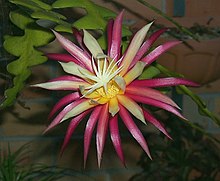Selenicereus
| Selenicereus | ||||||||||||
|---|---|---|---|---|---|---|---|---|---|---|---|---|

|
||||||||||||
| Systematics | ||||||||||||
|
||||||||||||
| Scientific name | ||||||||||||
| Selenicereus | ||||||||||||
| ( A. Berger ) Britton & Rose |

Selenicereus is a genus of plants fromthe cactus family (Cactaceae). Its botanical name is derived from Selene , the goddess of the moon in Greek mythology , and refers to the flowers that open at night. Several species of the genus are called "Queen of the Night" because of their large flowers that open at night. This often means Selenicereus grandiflorus .
description
Selenicereen are slender, stem succulent shrubs . They grow terrestrially and climb accompanying vegetation and / or grow climbing or hanging partially or completely epiphytically . The mostly 1 to 2.5 cm thick, several meters long rungs have up to ten mostly only slightly raised ribs. Sometimes the shoots are narrow-edged, strongly winged and flattened to leaf-shaped platycladia . These then have entire margins and are pressed tightly against the host plants for climbing ( Selenicereus testudo ) or are deeply cut into a frond-like structure ( Selenicereus chrysocardium ). The shoots often form aerial roots , which turn into real roots when they come into contact with the ground and the plants thus reproduce vegetatively . The areoles standing on the ribs have only a few short and needle-fine thorns and sometimes short-lived hair.
The flowers appearing individually from the areoles are specialized for pollination by bats . They open at night, often only for a few hours a night (“Queen of the Night”), sometimes for a few nights in a row. With a length and diameter of up to 30 cm, they are very large and usually pleasantly scented, rarely odorless. The ovaries and flower tubes have short spines on the outside and are sometimes hairy. The outer bracts are reddish to brownish, the inner ones are white to pale yellow. The numerous stamens are in two groups, the stylus is long, thick and often hollow. The large fruits that emerge after fertilization are usually red, rarely yellow, and contain many seeds in a juicy pulp .
Systematics and distribution
The distribution area of the genus Selenicereus extends from the southern United States through Mexico , Central America and the Caribbean to the north of South America .
Alwin Berger established Selenicereus in 1905 as a subsection of Cereus ( Cereus subsect. Selenicereus ). Nathaniel Lord Britton and Joseph Nelson Rose raised the subsection to the rank of genus in 1909. The type species of the genus is Cactus grandiflorus . According to David Richard Hunt , the genus can be divided into five sections with the following species:
- Section Selenicereus
- Selenicereus atropilosus Kimnach
- Selenicereus coniflorus (Vine.) Britton & Rose
- Selenicereus donkelaarii (Salm-Dyck) Britton & Rose
-
Selenicereus grandiflorus (L.) Britton & Rose
- Selenicereus grandiflorus subsp. grandiflorus
- Selenicereus grandiflorus subsp. Lautneri Ralf Bauer
- Selenicereus hamatus (Scheidw. Ex Pfeiff.) Britton & Rose
- Selenicereus hondurensis (K.Schum. Ex Weing.) Britton & Rose
- Selenicereus macdonaldiae (Hook.) Britton & Rose
- Selenicereus nelsonii (Weing.) Britton & Rose
- Selenicereus pteranthus (Link ex A.Dietr.) Britton & Rose
- Selenicereus rubineus Kimnach
- Selenicereus urbanianus (Gürke & Weing.) Britton & Rose
- Selenicereus validus S. Arias & U.Guzmán
- Section Salmdyckia D.R.Hunt
- Selenicereus extensus (Salm-Dyck ex DC.) Leuenb.
- Selenicereus inermis (Otto ex Pfeiff.) Britton & Rose
- Selenicereus innesii Kimnach
- Selenicereus megalanthus (K.Schum. Ex Vaupel) Moran
- Selenicereus murrillii Britton & Rose
- Selenicereus setaceus (Salm-Dyck ex DC.) Werderm.
- Selenicereus spinulosus (DC.) Britton & Rose
- Selenicereus tricae D.R. Hunt
- Selenicereus vagans (K.Brandegee) Britton & Rose
- Selenicereus wercklei (FACWeber) Britton & Rose
- Section Cryptocereus (Alexander) DRHunt
- Selenicereus anthonyanus (Alexander) DRHunt
- Section Strophocactus (Britton & Rose) DRHunt
- Selenicereus wittii (K.Schum.) GDRowley
- Section Deamia (Britton & Rose) DRHunt
- Selenicereus testudo (Karw.) Buxb.
The assignment of
- Selenicereus chontalensis (Alexander) Kimnach
- Selenicereus chrysocardium (Alexander) Kimnach
- Selenicereus dorschianus Ralf Bauer
is unclear.
Synonyms for the genus are Strophocactus Britton & Rose , Deamia Britton & Rose , Mediocactus Britton & Rose , Cryptocereus Alexander , Pseudoselenicereus Innes and Chiapasophyllum Doweld .
literature
- Edward F. Anderson : The Great Cactus Lexicon . Eugen Ulmer, Stuttgart 2005, ISBN 3-8001-4573-1 , p. 586-598 .
- Ralf Bauer: A synopsis of the tribe Hylocereceeae F. Buxb. In: Cactaceae Systematics Initiatives . Volume 17, 2003, pp. 3-63.
- Noemi Tel-Zur, Shahal Abbo, Dudi Bar-Zvi, Yosef Mizrahi: Genetic relationships among Hylocereus and Selenicereus vine cacti (Cactaceae): evidence from hybridization and cytological studies . In: Annals of Botany . Volume 94, No. 4, 2004, pp. 527-534.
Individual evidence
- ↑ Alwin Berger: A Systematic Revision of the Genus Cereus Mill . In: Missouri Botanical Garden Annual Report . 1905, p. 76, JSTOR 2400072 .
- ^ NL Britton, JN Rose: The Genus Cereus and its Allies in North America . In: Contributions from the United States National Herbarium . Volume 12, 1909, p. 429 ( biodiversitylibrary.org ).
- ↑ DR Hunt: Notes on Selenicereus (A. Berger) Britton & Rose and Aporocactus Lemaire (Cactaceae / Hylocereinae) . In: Bradleya . Volume 7, 1989, pp. 89-96.
- ^ Edward F. Anderson : The great cactus lexicon . Eugen Ulmer, Stuttgart 2005, ISBN 978-3-8001-4573-7 , pp. 586-594 .
- ↑ Ralf Bauer: Selenicereus dorschianus Ralf Bauer spec. Nov., A new species from western Mexico (Jalisco) with green fruits . In: EPIG . Number 64, 2009, pp. 5-19.
Web links
- The genus Selenicereus in the flora of North America (English: Flora of North America )




